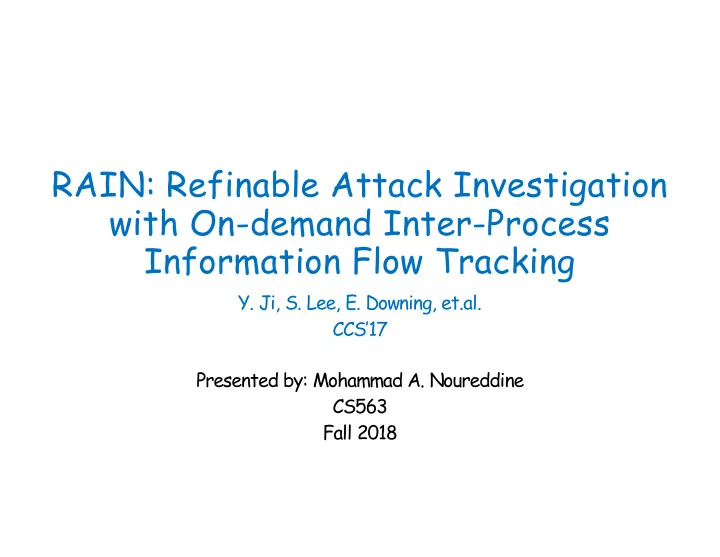

RAIN: Refinable Attack Investigation with On-demand Inter-Process Information Flow Tracking Y. Ji, S. Lee, E. Downing, et.al. CCS’17 Presented by: Mohammad A. Noureddine CS563 Fall 2018
No Shortage of Recent Breaches! 1
Investigating Attacks • Definition: Whole-system provenance • “A complete description of agents (users, groups) controlling activities (processes) interacting with controlled data types during system execution” 1 • Determine the root cause of a breach • Determine the impacts of an exploit on the system 2 1 Bates, Adam M., et al. "Trustworthy Whole-System Provenance for the Linux Kernel." USENIX Security Symposium . 2015.
Provenance Graphs • Track and Log system Interactions • Usually system-call level write read • From a given point of interest • Can determine root cause • Backward traversal • Can determine impact on the system read read read • Forward traversal 3
Provenance Graphs: Challenges write read “Dependence Explosion” Problem read read read 4
Traditional Approaches • Tradeoff performance vs graph granularity • System-call tracing • Better performance but not enough granularity • Dynamic Information Flow Tracking (DIFT) • Fancy name for taint analysis • Better granularity but worse performance • DIFT + record and replay • Performance hit becomes someone else’s problem 5
This Paper • RAIN: Refinable Attack INvestigation • Combine best of each approach! Good Runtime Performance • System-call level graph generation • Graph pruning Reduce performance hit of DIFT • Record & Replay • Selective DIFT Improved granularity! 6
What Can the Attacker Do? • Kernel: Good • Kernel and monitoring system form a trusted computing base (TCB) • User space: Bad • No side channels 7
High Level Overview 8
Logging Behavior • Logging component resides completely in the kernel • Trusted given the threat model of the paper • Capture system calls, their arguments, and return values • read, write, open, send, recv, connect • Build the same traditional provenance graphs • Keep logs not only to infer causality • Need to be able to faithfully replay the system’s execution 9
Record & Replay: Arnold • Capture non-determinism for later replay • Goal is to reproduce complete architectural state of a user process • Record IPC communications • Cache data of every file and network I/O • Record non-determinism by instrumenting pthread in libc • Enforce determinism when replaying 10
Story so far RAIN module RAIN module Provenance Provenance Graphs Graphs Still too Still too expensive for expensive for Record & analysis Record & analysis Arnold Arnold Replay Logs Replay Logs Runtime Collection Runtime Collection 11
PRUNING I: Triggering Points • Want to limit the size of the graph to the most interesting nodes • Three criterion for starting the analysis • External signals : tips from other sources, CVEs, responsible disclosures, etc. • Security policy : violations to a certain policy are interesting points for looking into • Customized comparisons : compare hashes of downloaded files 12
PRUNING II: Reachability Analysis • Starting from trigger points (points of interest) • Determine the next set of interesting poinst • Forward reachability • Backward reachability • Point-to-point: Forward & Backward • Heuristic interference analysis 13
Backward Reachability Analysis D read P2 write B read E P1 send read A read C Bad socket write P3 mmap F 14
Forward Reachability Analysis Bad File D read P2 write B read E P1 send read A read C write P3 mmap F 15
P2P Reachability D read P2 write B read E P1 send read A read C write P3 mmap F Bad File 16
Interference Pruning • Track read-after-writes using syscall timestamps • Remove false dependencies No memory P2 interference D read write read P2 write B read E P1 send read A read C write P3 mmap F 17
Digression • High dependence on the structure of the graph • What about loops? • Processes that touch system files • /etc, /var, /sys, … P2 write B write write read write E P1 send read A read C write P3 mmap F 18
Taint Analysis Primer • A process level PET scan P2 P1 a.txt Fine-grained causality b.txt Intel PIN tools 19
Selective DIFT • Use the outcomes of the reachability analysis and trigger points • Start from interference points • Refinement for • downstream causality, • upstream causality, • and point to point causality • Run taint analysis for different processes independently • Cache results for improved performance 20
DIFT: Upstream Refinement Does not influence A. D Drop this path! read Interference points. Run P2 taint analysis write Interference points. Run B taint analysis read E P1 send read A Does not influence C. read C Drop this path! write P3 mmap Continue down F True causality this path 21
P2P Refinement D read P2 write B read E P1 send read A read C write P3 mmap F Bad File 22
Story Recap RAIN module Provenance Replay Engine Graphs Fine-grained graphs Record & Arnold Selective DIFT Replay Logs Runtime Collection 23
Results: Accuracy “In addition, the point-to-point analysis between the “NetRecon.log” and neighboring hosts shows the effectiveness of RAIN involving control flow dependency” ----------- “When we took a closer look at the DIFT, we observed that “over-tainting” situation that occurs during control flow-based propagation which is a know limitation of DIFT”. 24
Results: Performance Hit 25
Limitations • Storage overhead • Over-tainting issue due to control flow dependencies • Kernel is a point of trust • What if exploit is in libc but logging is intact? 26
Questions • Attack that exploits a certain race condition? • Arnold is having an affair: “In the presence of data races, the replayed execution may diverge from the recorded one” 1 • Does record and replay as described work with containers? 27 1 Devecsery, David, et al. "Eidetic Systems." OSDI . Vol. 14. 2014.
Recommend
More recommend